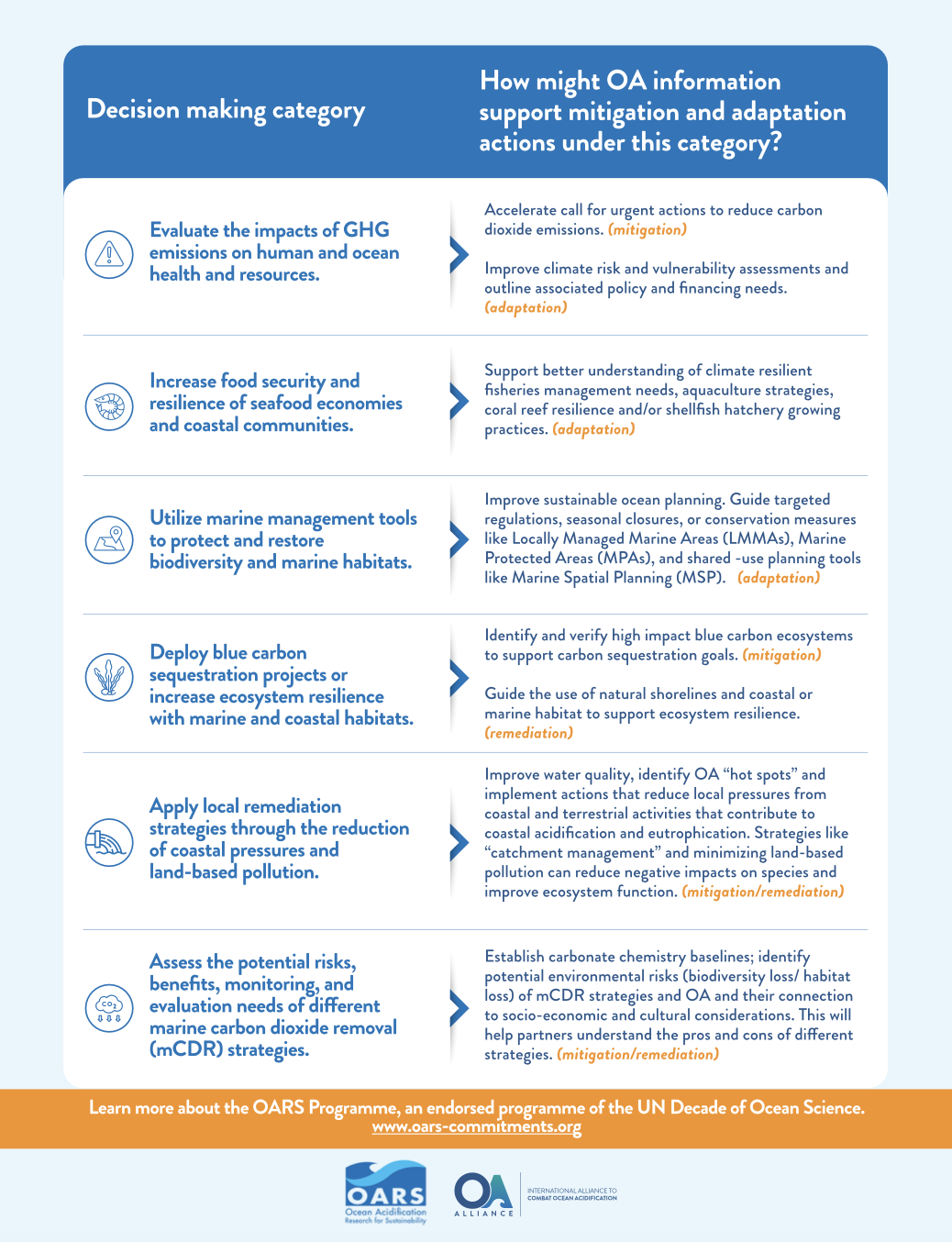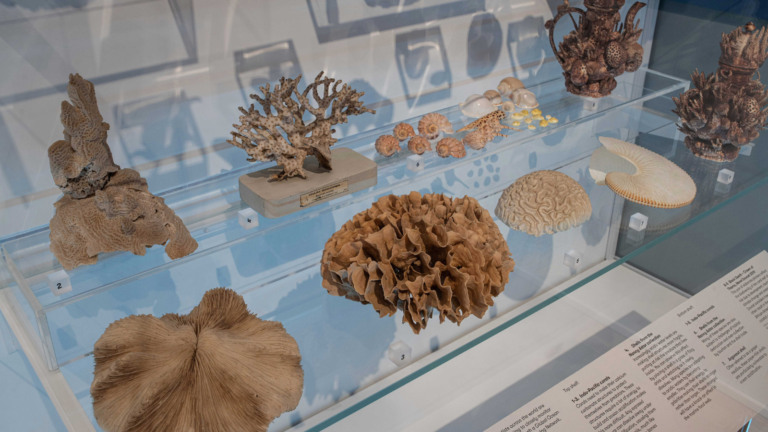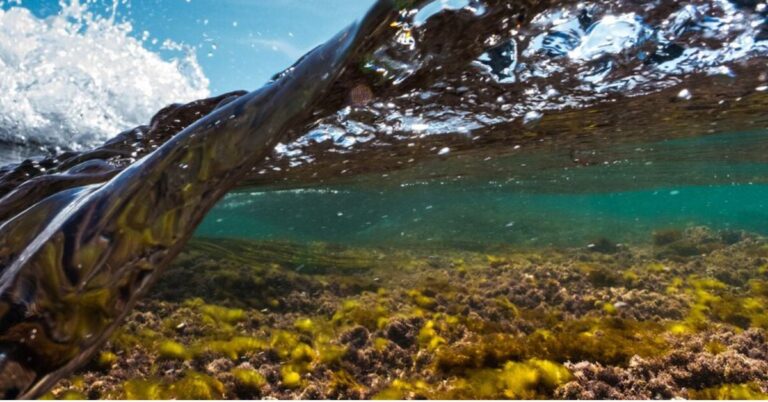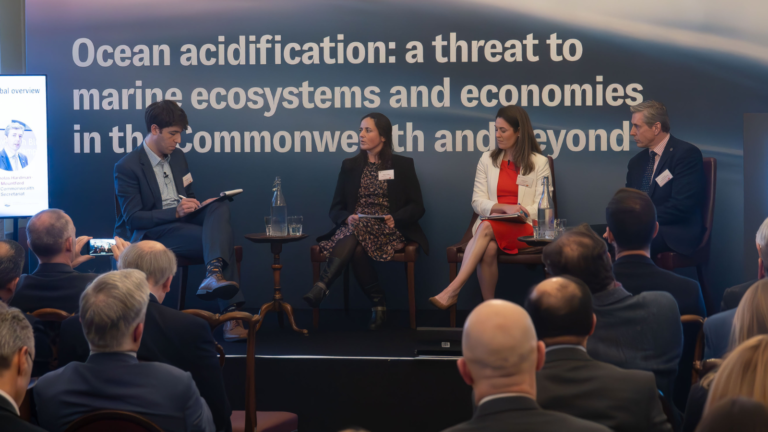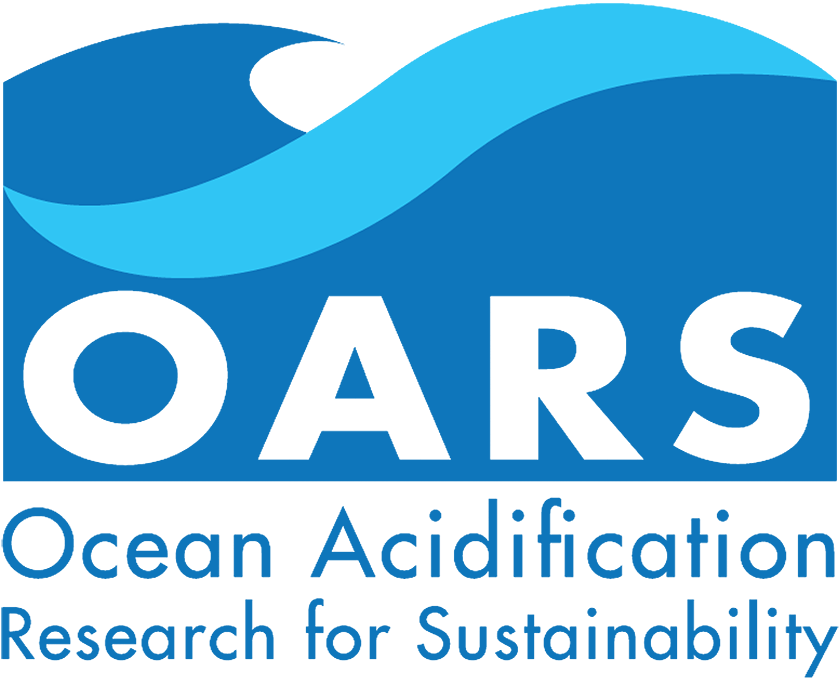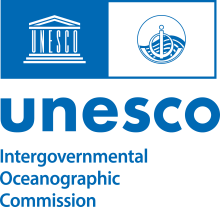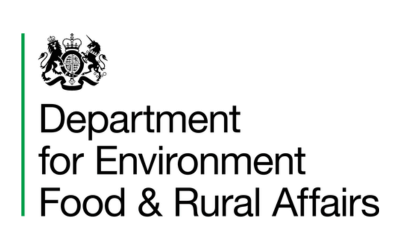About OARS
What is OARS?
Welcome to the Ocean Acidification Research for Sustainability (OARS) programme, a UN Ocean Decade endorsed programme building on the work of the Global Ocean Acidification Observing Network (GOA-ON) and the broad ocean acidification community.
Aligned with Sustainable Development Goal Target 14.3, OARS is dedicated to minimising and addressing the impacts of Ocean Acidification (OA) through enhanced cooperation at all levels. We are creating a network of scientists and other ocean professionals to provide systematic evidence of how ocean acidification is changing the chemistry of our oceans, how these changes impact the sustainability of marine ecosystems, and use this knowledge to underpin better management of marine resources. Through our efforts, we aim to foster collaboration and capacity-building and bridge the gap between cutting-edge research and practical applications.
OARS' Commitment to Ocean Acidification Communication and Action
OARS is committed to effective communication. We ensure that scientific findings in ocean acidification science are readily available to policy makers and communities, empowering them with the information needed to make informed decisions regarding mitigation and adaptation strategies.
Join us in our mission to not only understand the challenges posed by ocean acidification but also to develop and evaluate strategies to offset its future impacts and bring these to action. Together, we can safeguard the health and vitality of our marine ecosystems for generations to come.
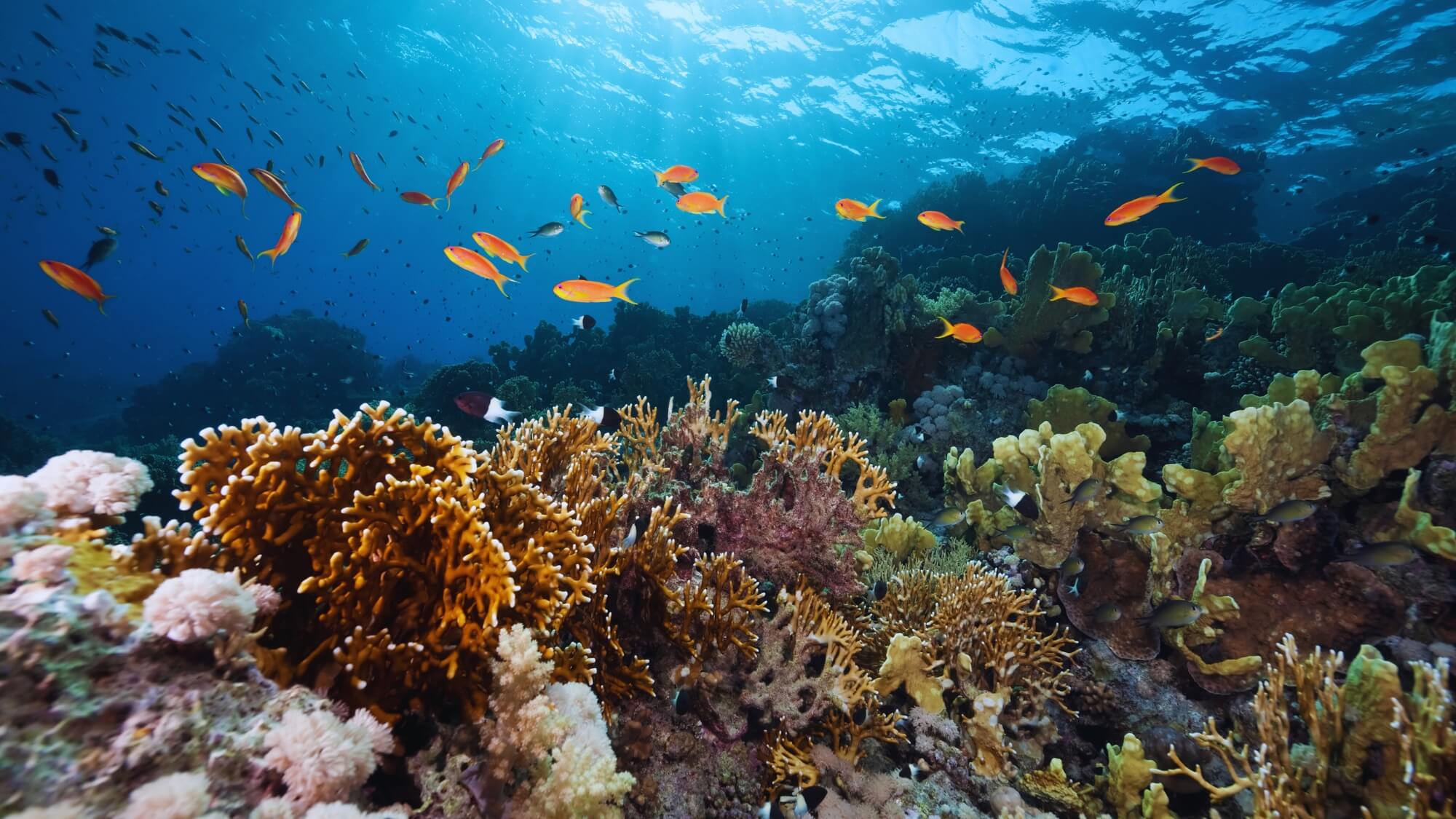
Our Mission
OARS aims to achieve the following Outcomes by 2030:
1. Quality data
The scientific community will provide ocean acidification data and evidence of known quality via capacity development, mentoring of early career researchers, facilitating data sharing, growing regional collaborations, and increased communication through meetings and workshops, allowing for a holistic analysis considering all stakeholder perspectives.
2. Science to Action
Data and evidence needs for mitigation and adaptation strategies will be identified and prioritised, from local to global. These needs are communicated to the scientific and science policy community to ensure that science is prioritised.
3. Observation strategies
Observation strategies are co-designed and implemented in collaboration with data/information producers and end-users. Factors limiting collection of data are identified and solutions are implemented. Observation strategies are proactively designed and implemented to ensure vulnerable areas are adequately monitored. Ocean acidification baseline information is available for newly developed carbon removal strategies.
4. Biological Impacts
Ocean acidification impacts on marine organisms and ecosystems is better understood to protect marine life. Biological observation is implemented within ocean acidification monitoring, providing the possibility to improve predictions of vulnerability and resilience to ocean acidification at all temporal and spatial scales.
5. Future Predictions
Appropriate, societally relevant predictions and projections of ocean acidification trends and impacts are available for all ocean ‘users’, employing new technologies such as digital twins, to support adaptation and mitigation actions and strategies.
6. Public Awareness
The public are more informed about ocean acidification, its sources, and impacts, achieved via ocean literacy and public outreach.
7. Policy Engagement
Strategies and solutions exist that enable countries and regions to include ocean acidification evidence in their respective policy and legislation.
Spotlight on Outcome #2:
Science to Action
OARS Outcome #2 is helping to prioritize monitoring, research, and information for tangible outcomes by considering the information and tools needed for specific decisions and actions.
Targeted information can help policymakers, resource managers, stakeholders, and communities better understand impacts of OA on marine resources, and enable them to identify the most appropriate mitigation or adaptation actions to minimize and address the effect of OA.
Implementing actions to minimize and address the effect of OA requires considerations of: (1) time, space, and cost constraints; (2) alignment with existing policy or management goals; and (3) assessment of broader environmental and socio-economic risks and benefits.
To encourage a diversity of OA actions across different scales, OARS Outcome #2 has outlined 6 key decision-making categories. These categories provide a framework for identifying targeted or increased OA information needs for mitigation and adaptation actions.
Science to Action Case Studies
Case studies provide examples for how OA information can be applied to support mitigation or adaptation actions under each category. The OARS Outcome #2 Working Group invites scientists, policymakers, resource managers, stakeholders, and communities to identify additional OA projects within each category.
Evaluate the impacts of GHG emissions on human and ocean health and resources.
Project Leads: University of Washington, Coastal Treaty Tribes, NOAA and partners
Timeframe: 2017 – 2022
Description: The Olympic Coast region in the Pacific Northwest of the United States is already experiencing effects of ocean acidification. This poses risks to marine resources that are important to communities, especially indigenous tribes who are rooted in this place and depend on treaty-protected rights to marine resources like shellfish and salmon. This project brings together social science research, synthesis of existing chemical and biological data from open ocean to intertidal areas, and model projections, to assess current and projected Olympic Coast vulnerabilities associated with OA. This critical research aims to increase the Tribes’ ability to prepare for and respond to OA through respective community-driven strategies. By constructing a comprehensive, place-based approach to assess OA vulnerability, decision-makers in the Pacific Northwest will be better able to anticipate, evaluate and manage societal risks and impacts of OA. This collaborative project was developed in partnership with Tribal co-investigators and regional resource managers from start to finish, and is rooted in a focus on local priorities for social, cultural, and ecological health and adaptive capacity.
General frequency of OA measurement that is most important for this project:
Multiple frequencies. For oceanographic and biological: real-time and historic observations, and seasonal and decadal model projections. For social science: real-time and generational, as well as the past 20 years in 5-year intervals.
Factors or variables that were most relevant to undertaking this OA project:
Alignment with existing policy or management goals, socio-economic risk assessment, and strong and enduring collaborative relationships spanning community members, tribes, managers, educators, researchers, agencies, and universities.
Increase food security and resilience of seafood economies and coastal communities.
Project Lead: International Atomic Energy Agency (IAEA)
Timeframe: 2018 – 2023
Description: Concern about the impacts of ocean acidification on economically and socially important seafood is increasing world-wide, and ocean acidification is now an integral part of the United Nations 2030 Agenda for Sustainable Development. This project was designed to meet IAEA Member States’ need to advance understanding about the effects of ocean acidification on key seafood species, and to explore adaptation strategies for aquaculture and food industries. Through a novel collaborative approach, this project assessed the impacts of OA on species of oysters, mussels, shrimps, lobsters and fish across 13 geographical locations around the globe. Impacts are characterized by a variety of climatic, geo-physical, chemical and ecological systems. In addition to using knowledge and research kits developed through the IAEA OA International Coordination Centre (OA-ICC)’s capacity-building programmes, project collaborators explored innovative approaches to study the effects of OA on food security, including novel ways of applying nuclear and isotopic techniques to this field of study. By expanding international collaboration on OA, this project provides Member State governments with new perspectives and strategies on how to build resilience to the impacts of ocean acidification in their respective coastal and marine waters.
Type of research conducted in this project:
Laboratory manipulation experiments, social science.
Factors or variables that were most relevant to undertaking this OA project:
Socio-economic risk assessment.
Utilize best applications of marine management tools to protect and restore biodiversity and marine habitats.
Project Leads: Vancouver Island University, TULA Foundation, Province of British Columbia, MEOPAR and DFO
Timeframe: 2019 – present
Description: The Baynes Sound region is the most farmed shellfish area in the province of British Columbia, Canada and shellfish are particularly vulnerable to ocean acidification and hypoxia (OAH). As such, an enhanced awareness of in-situ biogeochemical conditions in the Baynes Sound region is a key step toward improving decision making about marine management and increasing seafood resilience. The Baynes Sound OA observatory’s ocean monitoring buoy has functioned as a sentinel site for OA monitoring in the Sound since 2019, providing continuous high-resolution, real-time measurements of in-situ pCO2, CTD, pH, and dissolved oxygen. Biogeochemical data from the Baynes Sound mooring is freely available to anyone around the world in near real-time. This remarkable open access data availability is critical for rapid knowledge translation and for disseminating interpretations related to OAH conditions across multiple diverse stakeholder groups, from decision makers in the highest levels of government through to local shellfish farmers and anyone in between. This project aims to ultimately create translational knowledge that can be applied in the aquaculture industry to make informed ecological, economic, and cultural decisions related to shellfish farming and to enhance coastal resilience.
Type of research conducted in this project:
Model projections, synthesis of existing data, chemical and biological data from intertidal areas.
Factors or variables that were most relevant to undertaking this OA project:
Alignment with existing policy or management goals, environmental co-benefits, socio-economic benefits, cultural benefits.
Deploy blue carbon sequestration projects or increase ecosystem resilience with marine and coastal habitats.
Project Leads: SeyCCAT, University of Oxford, Blue Economy Research Institute – UniSey, and numerous partners
Timeframe: 2019 – present
Description: In its latest Nationally Determined Contribution (NDC) to the Paris Agreement 2015, the Republic of Seychelles committed to preserving 100% of the nation’s seagrass meadows by 2030, toward including blue carbon ecosystems in its national greenhouse gas inventory. In order for Seychelles to claim a nature-based solution as a mitigation component of its nationally determined efforts, the country must be able to measure how this solution is supporting carbon sequestration efforts and outline strategies for ongoing management of the ecosystem. This project responds to the needs of the government to gather spatial data on the distribution of seagrass meadows and to validate their potential to sequester carbon.To this end, an inventory of seagrass meadows in Seychelles Exclusive Economic Zone (EEZ) was conducted using best practices for blue carbon determinations. Satellite seagrass detection is associated with a field component to ground-truth geospatial information using camera imagery, large dataset processing tools, sediment cores, and coastal punctual CTD deployments. This critical research aims to provide the government with accurate sequestration rates (tCO2e/yr) to inform the development of the NDC and national policies for management of these critical habitats. As partners prepare to map seagrass across the Western Indian Ocean, this project serves as an example of long-term research that promotes a science-to-policy loop for harnessing the remarkable value of seagrass to nature, coastal communities, and the blue economy.
Type of research conducted in this project:
Social science, synthesis of existing data, chemical and biological data from intertidal areas and the open ocean.
General frequency of OA measurement that is most important for this project:
1 – 8 years.
Factors or variables that were most relevant to undertaking this OA project:
Alignment with existing policy or management goals, environmental co-benefits, socio-economic benefits, cultural benefits.
Case Study: Utilizing Cultivated Kelp Beds as an OA Remediation Tool in Namibia
Project Leads: Kelp Forest Foundation, Kelp Blue, University of Namibia, Victoria University Wellington (Te Herenga Waka)
Timeframe: 2024 – 2025
Description: The Kelp Forest Foundation aims to fill the gaps in science around the various ecosystem services of giant kelp forests, both wild and cultivated, with a focus on carbon sequestration potential. This new research project explores the role of cultivated giant kelp (Macrocystis pyrifera) in mitigating ocean acidification and promoting bioremediation through co-growing practices. By harnessing the natural abilities of seaweed to draw down dissolved carbon dioxide during photosynthesis and to absorb excess nutrients, the initiative aims to contribute valuable data to the GSC. This project will undertake studies to investigate seaweed’s potential at mitigating ocean acidification within Kelp Blue’s commercially active kelp farm in Namibia. Researchers will assess kelp’s ability to contribute to increased local pH and alkalinity levels within the kelp farm and the diffusive region immediately surrounding the farm where the kelp’s influence on seawater chemistry can be measured, as well as the corresponding effect on calcifying organisms that settle on Kelp Blue’s farm structures. Project goals include informing the magnitude and seasonality of giant kelp’s potential mitigative properties, and collecting data that describes the influence of kelp canopies shell calcification rates, with the potential to demonstrate a relationship for the co-growing of kelp and shellfish. The Kelp Forest Foundation is dedicated to raising awareness of the ocean acidification mitigation benefits of giant kelp cultivation as a scalable and replicable solution for local OA mitigation.
Type of research conducted in this project:
Biological data from intertidal areas, biogeochemistry data from in and around the giant kelp cultivation pilot area.
General frequency of OA measurement that is most important for this project:
1 – 10 days.
Factors or variables that were most relevant to undertaking this OA project:
Cost, environmental co-benefits, socio-economic benefits.
Advance local remediation strategies through the reduction of coastal pressures and land-based pollution.
Project Lead: Oregon Department of Environmental Quality
Timeframe: 2022 – 2023
Description: Integrating ocean acidification science into existing water policy frameworks such as the U.S. Clean Water Act is a challenging process, but provides a critical step in helping water quality practitioners and policymakers prepare for climate related changing ocean conditions. Starting in 2022, the Oregon Department of Environmental Quality (DEQ) convened a scientific technical workgroup to assist in drafting methodologies for assessing the impacts of ocean acidification and marine dissolved oxygen (hypoxia) in Oregon’s territorial waters. The objective of DEQ’s ocean acidification and hypoxia (OAH) technical workgroup was to synthesize evidence that could support management decisions on determining impairment from ocean acidification and hypoxia within Oregon’s territorial waters. Workgroup members brought a range of specialized regulatory, research, and academic perspectives to the meetings. The workgroup was not a decision-making body. Rather, it facilitated the sharing of scientific data and information, and members provided technical review of DEQ’s proposed methodologies. These methodologies will be used by the state of Oregon to identify and report potential impairments caused by ocean acidification and hypoxia in state waters. This information will be reported to the US Environmental Protection Agency through Clean Water Act reporting. If impaired waters are identified, the state is required to develop a management plan focused on water body restoration and resilience, which could include reducing land-based pollutants that exacerbate coastal acidification and hypoxia. Long term goals include filling in data gaps across nearshore marine environments and supporting strategic investments in science and research. This information will continue to inform coastal/marine assessment, water quality management, and decision-making that increases resilience.
Type of research conducted in this project:
Synthesis of existing data.
General frequency of OA measurement that is most important for this project:
1 – 3 decades.
Factors or variables that were most relevant to undertaking this OA project:
Alignment with existing policy or management goals.
Assess the potential risks, benefits, monitoring, and evaluation needs of different marine carbon dioxide removal (mCDR) strategies.
Project Lead: Monterey Bay Aquarium Research Institute, MRV Systems, and WHOI
Timeframe: 2025
Description: As interest in strategies like marine carbon dioxide removal (mCDR) continues to grow, scientists, industry partners, governments and local communities need shared frameworks for monitoring, reporting, and verifying different marine carbon dioxide removal strategies. In 2025, Woods Hole Oceanographic Institution (WHOI) researchers will conduct the first large-scale field trial of ocean alkalinization enhancement. While practitioners at WHOI will monitor the efficacy and associated ecological response of this field trial in the Gulf of Maine using research vessels, Monterey Bay Aquarium Research Institute (MBARI) will run a parallel test to determine how autonomous technology can be used to monitor mCDR efforts. Leveraging MBARI engineering expertise, this project will outfit a fleet of five Spray2 gliders with smaller, more power-efficient pH sensors to observe interventions and independently assess carbon removal and ecosystem response. Prior to the start of alkalinization enhancement, the gliders will establish a biogeochemical baseline for the natural ebb and flow of carbon in the area. Once alkalinization enhancement gets underway, the gliders will track how much additional carbon is being stored in the ocean. This glider-based field project will lay the foundation for future experiments, and ultimately for industry, to build upon. The team hopes to gain insight into the ways autonomous technology can strengthen mCDR monitoring efforts and advance cost-effective monitoring, reporting, and verification of ocean alkalinity enhancement strategies.
Type of research conducted in this project:
Chemical data from open ocean.
General frequency of OA measurement that is most important for this project:
Real time.
Factors or variables that were most relevant to undertaking this OA project:
Cost.
The Importance of OARS
The ocean covers over 70% of the Earth’s surface, regulates climate, and provides a habitat for an incredible diversity of marine species. Additionally, they supply sustenance and livelihoods for billions of people around the world. Preserving the health and balance of our oceans is not only an environmental concern but a global imperative.
Ocean acidification is a direct consequence of the increased concentration of CO2 in the atmosphere resulting from human activities such as the burning of fossil fuels. When excess CO2 is absorbed by seawater, a series of chemical reactions occur, resulting in a decrease in pH levels. Although the ocean isn’t acidic, this change in pH towards a more acidic state disrupts the delicate balance that many marine organisms, like corals, shellfish, and some plankton, rely on to build and maintain their skeletons and shells.
Addressing ocean acidification is not only a moral imperative to protect the planet’s biodiversity but also a matter of self-preservation for humanity. The choices we make today will determine the future of our oceans and, consequently, the health of our planet.
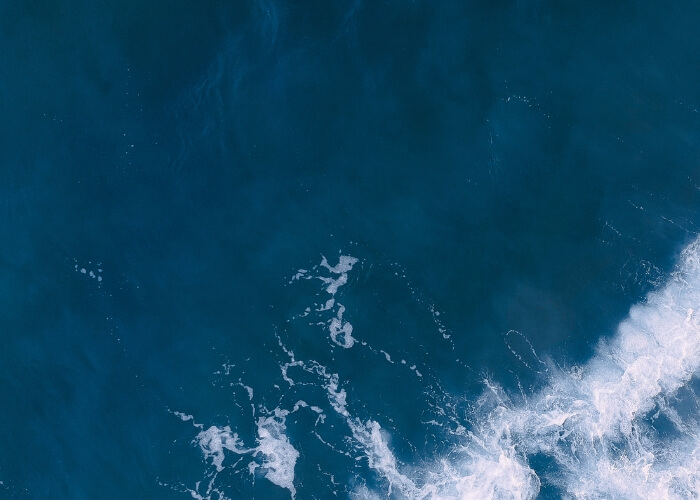
IMPACTS
Marine Life
Coral Reefs
These vibrant and diverse ecosystems, often referred to as the “rainforests of the sea,” are particularly vulnerable. Rising acidity levels inhibit the ability of corals to build their calcium carbonate skeletons, threatening their survival.
Shellfish and Molluscs
Species like oysters, clams, and mussels face challenges in forming and maintaining their protective calcium carbonate shells, affecting their ability to grow and reproduce.
Plankton
These microscopic organisms are the foundation of marine food webs. Changes in pH levels can disrupt their ability to form and maintain their tiny calcium carbonate structures, potentially cascading up the food chain.
Fisheries
Acidification can have far-reaching impacts on the fish populations that millions of people rely on for food and livelihoods. Disruptions in the food web can lead to declines in commercially important fish species.
Economic Consequences
The economic repercussions of ocean acidification are far-reaching. Fisheries, tourism, and coastal communities all face substantial risks. The livelihoods of millions are at stake, and the ripple effects can extend globally, affecting food security and economic stability.
Climate Regulation
The ocean plays a critical role in regulating the Earth’s climate. It acts as a carbon sink, absorbing a significant portion of the excess CO2 in the atmosphere. However, this comes at a cost—acidification diminishes the oceans’ capacity to sequester carbon, further exacerbating global warming.
HOW YOU CAN HELP
Only if we all rally together will we be able to achieve the SDG target 14.3 to reduce the impacts of ocean acidification. We need everyone, from governments to scientific institutions, scientists, engineers, and the media to address ocean acidification. Please make a commitment and let us know what you will do to be a part of this global effort to tackle ocean acidification.
